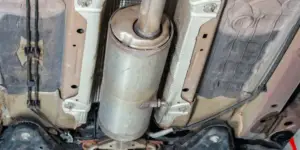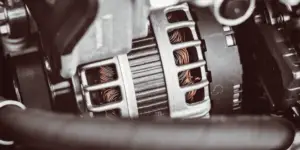
All air conditioners, whether it is a standalone unit or one in a vehicle, have a relay in them. This is an electrical switch that turns the AC on and off. If all is going well, you’ll never need to touch the AC’s relay. But, the older the AC gets, the more likely that relay is to start having issues. If you look online, you may see a tip to tell you to bypass the relay. But, if the air compressor only works when the relay is bypassed, how do you diagnose the problem?
There are two reasons why your AC may only work when the relay is bypassed. Either the relay is broken, or the freon levels in your air conditioner are running low. In order to fix, you need to replace the relay or refill the freon. Both of these problems are easily remedied by a professional.
On this page, we want to help you to troubleshoot why your relay may be causing issues in your air conditioner. We are going to take a look at this from the perspective of a vehicle’s AC (since this is the situation most people bypass the relay), but much of the troubleshooting methods will apply to full-sized ACs too. Although, we wouldn’t recommend that you fiddle about with a standalone AC unless you know what you’re doing.
What Is The Purpose of the Relay in Your AC Compressor?
You can think of the relay in your AC as a switch. It works like this:
- When you turn the AC on, power starts to flow toward the relay.
- When the power goes through the relay, the relay closes.
- When the relay is closed, power continues on through to the AC’s clutch, turning the AC on.
- When power stops flowing through to the relay, the relay opens, shutting off the air conditioner.
Relays control the amount of power flowing through to the compressor. The relay ensures that the AC is only powered when the air temperature is higher than the temperature on the thermostat.
Why Is Your AC Compressor Only Working When The Relay is Bypassed?
There are two main reasons why the AC compressor may only work when you bypass the relay:
- The relay is damaged
- The freon gas levels in your AC are low.
Unfortunately, the symptoms of both are the same, so it’ll take a bit of in-depth troubleshooting to try and work out what the issue is. Although, both problems are also very easy to fix (we’ll come to that in a short while).
1. The Relay is Damaged
If the AC relay has damage, then you may notice the following:
- The AC doesn’t get as cool as it used to.
- There may be intermittent cooling
- You may notice a burning smell coming from the vehicle’s AC system.
At this point, the relay still works, but it is on its way out. Eventually, the relay will stop working altogether. As a result, you won’t be able to switch your AC on at all. If you try, it may make a small clicking sound (as power is still sent through to the relay) but the relay isn’t engaging.
When you bypass the relay, it will fix all of the other problems. This is because the rest of the system is working fine. It is just the relay that has the issues.
2. Low on Freon
Freon is what your vehicle’s AC uses to cool the air. Freon turns from gas to liquid, and then back again. As it does this, it saps heat from the air. Basically, your vehicle’s AC needs freon to run or it can’t cool anything down at all.
When your vehicle starts to run low on freon, you’ll spot much the same signs as if the relay were damaged. So, the air won’t cool properly, the AC doesn’t seem to work all the time, etc. You won’t notice a burning smell, though.
Because it is dangerous to run an AC without freon, your vehicle’s AC will have a variety of safety mechanisms in place. One involves checking the pressure of the freon. If the freon drops too low, then the relay shouldn’t engage.
So, if your freon falls too far, that relay won’t work. However, you can get around it by bypassing the relay (sometimes). The difference is that unlike with a broken relay, bypassing the relay won’t fix the problem. Your vehicle’s air still won’t cool down properly, and running the AC may be dangerous.
What Causes Freon Levels to Drop?
Thankfully, it is rare that freon levels will ever plummet to this point. Well, as long as you are regularly servicing your vehicle’s AC. Freon doesn’t just magically disappear. The AC is a sealed unit. If you have dangerously low freon, then one of the following has happened:
- You haven’t had your vehicle’s AC serviced in years.
- There is a leak somewhere in the system. You can look for pooling liquid under the vehicle.
There are ways to check the freon levels in your vehicle. This will depend on the type of AC that you have, though. This means that you’ll need to check your vehicle’s manual to see how to do it. Although, rarely is this enough. You’re also going to need to fix whatever is leaking, or you’ll constantly be dealing with that problem.
Why It Is Not Good to Bypass the Relay on the AC
Since your AC is working when you bypass the relay, you may be wondering whether you can leave it like this. The answer is; no. While it is fine to bypass the relay once or twice, it isn’t a long-term solution. There are a couple of reasons for this.
Firstly, the relay plays a vital role in ensuring that the AC is only running when it needs to be running. It regularly shuts off the power, ensuring that the AC doesn’t consume too much power. If you bypass the relay, then energy bills will go up. If you bypass the relay in your vehicle, then you may end up draining your vehicle’s battery.
In addition to this, you don’t want the AC to be constantly running. This puts a huge amount of wear on the AC’s components. This means that, sooner or later, the AC is going to break. Trust us, the cost of repairing it will be a lot, a lot higher than just fixing the AC relay (or replacing the freon).
How To Fix an AC That Only Works When You Bypass the Relay
As we said, you can avoid bypassing the relay with a bit of knowledge. Although, we do suggest that you consult with an expert, especially if you have a standalone unit rather than one in your vehicle. They can give the AC a quick lookover to make sure that there are no major issues with the system.
Here is a quick guide to fixing the problem in a vehicle, though.
1. Replacing the Relay
Replacing the relay is easy. You just need to pick up the right replacement part. They shouldn’t be too tricky to find if you find a decent spare parts retailer.
Now you just need to follow these steps:
- Disconnect the vehicle’s battery.
- Locate the relay in your vehicle. Check your vehicle’s operating vehicle as things do differ from model to model.
- Gently remove the relay from the socket. Use a pair of pliers, but we cannot stress enough how gentle you need to be.
- Slot the new relay into place.
- Reconnect your vehicle’s battery.
2. Refilling the Freon
This is called ‘recharging’ your AC. We wouldn’t really recommend doing this unless you know what you’re doing. While refilling the freon isn’t a tough job, fixing any leaks can be. It needs experience. So, we suggest you head to an AC specialist instead.
If you do want to fix the problem yourself, then you’ll need to buy a freon recharge kit. It comes with the freon plus some accessories. You’ll then need to locate the AC service port on your vehicle. Once you have, follow these instructions:
- Attach the charging hose (supplied with your kit) to the AC service port.
- Add your freon, as per instructions supplied with your kit (they vary depending on the kit)
- Keep an eye on pressure levels as you refill. You don’t want them to be too high or too low.
- Remove the hose
- Reseal the charging port.
Conclusion
If your AC compressor only works when you bypass the relay, it is likely that you have a damaged relay. Removing the relay and installing a new one will fix the problem. If that doesn’t work, then freon levels in your AC could be low. This could indicate a leak, so we suggest you consult with an AC repair specialist to get that dealt with.
Frequently Asked Questions
Can You Bypass the Relay on an AC?
You can, but we don’t recommend it. It will cause serious wear and tear on your AC, and it will increase power consumption.
How Do You Know If a Relay in an AC is Damaged?
If your AC is not switching on at all, then the relay is likely damaged. Before it fully breaks, you may notice that the air doesn’t get as cool as normal, or there is intermittent cooling.
How Long Does a Relay Last?
It depends on how often you use the AC. Most last between 5 to 10 years.













